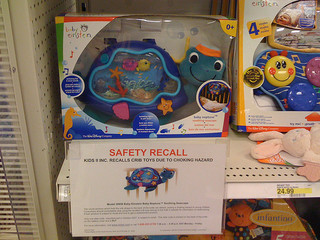Can my everyday products harm me?
Author: Nickey Williams
Published: Jul 11 2013
Manufacturers design and build products to meet a specific demand at a specific price. When the process breaks down at the design, manufacturing, or labeling stage, the marketplace will be exposed to a defective product. If that defect is capable of causing harm to innocent users or bystanders, it may be necessary to recall the product. Unfortunately, this does not always happen until it is too late.
Everyday Products to be cautious of:
1) Asbestos The most infamous example of a useful and widely marketed product with hidden dangers is asbestos. Asbestos is a set of minerals that have been in use for thousands of years as key components of fire-resistant materials. During the Industrial Revolution, asbestos was widely used as an effective insulator and could be found in everything from concrete to drywall joint compound. Asbestos is still in limited use today in some of the same roles. Over time, it was discovered that asbestos causes a wide variety of health risks.

Asbestos fibers are small, sharp and easily become airborne when material is disturbed. The most serious health risks occur when victims inhale these fibers. Inhaling asbestos fibers can cause a variety of pulmonary issues, some of which are terminal. Prolonged exposure to airborne asbestos fibers can cause lung cancer and mesothelioma, a specific form of cancer of the mesothelium cells. The resultant litigation comprises the longest-running and most expensive mass tort claim in U.S. history. Asbestos abatement is now an entire industry.
2) Kids Toys Not every defective and harmful product involves such extensive litigation and notoriety. Examples that are more mundane abound with children’s toys; many toys used by small children are later discovered to be a choking hazard via a poor design or manufacturing defect that causes the product to break in a potentially hazardous way. Personal injury lawyers Albany NY based reminds us that, each year, hundreds of products are recalled in the United States." Product manufacturers, wholesalers, and retailers are responsible for ensuring that the products they make and sell to consumers are safe.
3) Vehicles The automobile industry is also prone to such recalls; Ford recently recalled nearly 390,000 vehicles due to a defective gas tank component, which could cause a gas leak.
What To Do If Your Product Has Hidden Dangers:
1) Recognize a Risk Too often, the first signs of a problem with the product involve someone being injured and filing a lawsuit. However, particularly vigilant customers may recognize a risk factor before the manufacturer knows about it. The problem can be anything; a poor electrical connection in a sub-assembly that appears to be shorting can result in a fire, or a heavy piece of equipment supported by weak brackets can result in a loss of support.
2) Discontinue Use If you have a product and recognize a potentially dangerous situation, the first step to take is to discontinue the use of that product. Then, notify the manufacturer. If the defect is hazardous when the product is used as designed, the manufacturer can redesign the product. If the defect involves the product’s potential for misuse, like a cosmetic product that is toxic if ingested, the manufacturer can recall existing units and place warnings on future packaging.
3) Report Any Issues There are a number of ways for the manufacturer to deal with such a problem, but some manufacturers will not be responsive to complaints about the safety of the product. In the United States, customers can also contact the Consumer Product Safety Commission (CPSC). The CPSC has the authority to implement regulations or ban certain products that do not adhere to federal safety standards. Customers and businesses alike can report unsafe products at SaferProducts.gov.
4) Choose Safer Products When replacing the product, carefully review the new product’s packaging. Look for products that are less likely to have such defects. Environmentally friendly products often contain reduced levels of hazardous chemicals, making them safer for use around humans. Such products often use lighter materials, which may also be stronger.
What to Do if an Injury Occurs
1) Seek Medical Attention If an injury occurs as a result of a defective product, seek medical attention for the injured party. Whether the injury is a mild burn or a life-threatening situation, it is important that the victim takes steps to mitigate the damage caused by the defective product. Allowing a relatively minor wound to become infected will cause unnecessary pain and suffering, and may jeopardize any legal action taken.
2) Seek Legal Advice Seek legal counsel after seeking medical treatment. An experienced attorney can provide sound legal advice and represent you in your dealings with insurance providers and the manufacturer itself. Manufacturers are liable for harm caused by defective designs, defective production, and even defective marketing and labeling practices. Without the threat of legal action, manufacturers have little incentive to change, and dangerous products will remain in the marketplace.
There should never be any safety issues regarding products purchased, given or stationed in our everyday environment, but due the society we live in things are not always done ethically. Therefore, diligence is required in order to ensure safety. Use of the previous tips on what to be cautious of and what to do will help in efforts to reduce injuries.
Researcher Nickey William writes this article to continue product safety awareness efforts. Bottar Leone personal injury lawyers Albany NY based steadfastly fight injury cases that involve unsafe products in which failures range from serious to minor, and they will stop at nothing to protect their clients' safety and well-being.
Photo Credit: http://www.flickr.com/photos/xurble/2482748303/
***RESPONSIVE_AD***This article is published on the basis that the supplied content is the original work of the author / provider. If you feel that copyright has been infringed, please contact the site administrator.
B-0
